In 2025, nearly 64% of brands plan to work with influencers, whether it's to reach new audiences or appeal to their existing ones. Either way, these brands tend to run into several issues when trying to track their influencer campaigns. Right off the bat, it can be tricky to link conversions and sales to influencer content.
Beyond that, there are also concerns about fake followers and engagement. When running campaigns with multiple influencers across social media platforms, it can be overwhelming to manually keep an eye on each influencer's performance, not to mention the time-consuming process of compiling data and analyzing results.
In response to these challenges, influencer tracking platforms emerge as optimal solutions. These tools and software offer features like influencer management, fraud detection, reporting and analytics, influencer identification, and more. The following are some of the best influencer tracking platforms on our radar.
- 1. Brandwatch Influencer Marketing Software
- 2. Sprout Social
- 3. Hootsuite
- 4. Loomly
- 5. Modash
- 6. Upfluence
- 7. IQfluence
- Reliable Data, Real Results: Getting Accurate Influencer Metrics
- Building Trust & Compliance: Transparency in Influencer Tracking
- Monitor, Optimize, and Adapt to Stay Ahead in 2025
- Frequently Asked Questions
1. Brandwatch Influencer Marketing Software
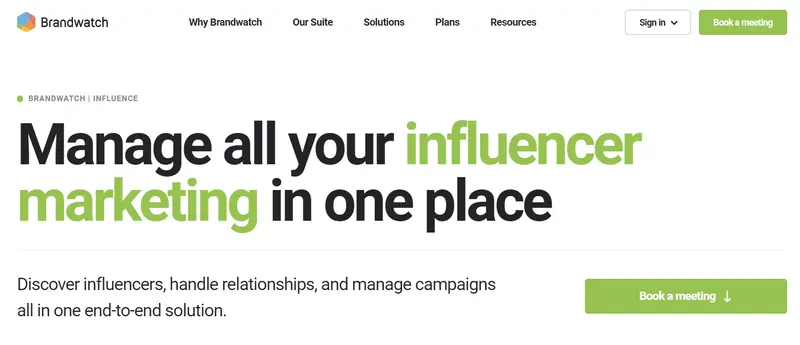
Best For: Brands and marketers that want to manage their overall social media marketing and consumer sentiment in one place.
Brandwatch’s suite of social media management, consumer intelligence, brand monitoring, and influencer marketing features makes it a one-stop for managing influencer campaigns in the broader context of social media marketing. The platform’s influencer marketing faction, Influence, has all the capabilities you need to find and track influencers.
To start, you get access to a repository of 30 million global creators from which to choose influencers. Besides engagement, you can find influencers by their niche, location, audience demographics, and bio keywords. The platform also analyzes the conversations around potential influencers to give you a better idea of their audience’s sentiments and interests.
Brandwatch offers robust engagement metrics that you can use to monitor your creators’ and campaign’s performance. For each campaign (and creator), you can see the total engagements, impressions, video plays, video views, and so on.
Since there’s a centralized campaign dashboard, Brandwatch lets you monitor the success of your influencer marketing strategy across platforms. You can further generate real-time reports from this data and measure your ROI.
Why It Stands Out: Besides mainstream influencers, Brandwatch also helps you discover trusted journalists, experts, and employees in your niche to amplify your brand’s messaging. You can further track these thought leaders’ performance and impact through a platform-calculated influencer score.

Key Features: Global Influencer Payment, Influencer Discovery, Influencer directory management, Creation of private influencer network, Campaign management and reporting, Broad platform coverage, Automated reporting,
Channels: YouTube, Facebook, Instagram, Twitter, Twitch, TikTok, Shopify
2. Sprout Social
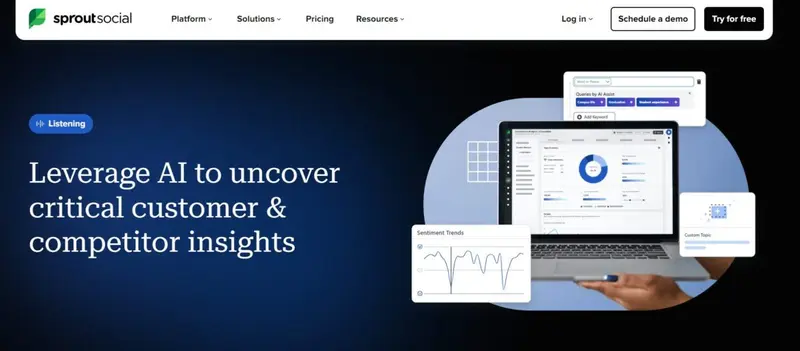
Best For: Brands that want to track historical as well as real-time influencer content and performance.
Sprout Social Influencer Marketing (previously called Tagger) is an all-in-one solution for influencer discovery, management, content performance, campaign curation, and reporting. With 50+ filters for influencer identification, the tool makes finding the perfect match a breeze. Its affinity engine is a machine learning-based algorithm that identifies influencers based on their predisposed interest in your product or brand.
As Sprout Social allows you to use customizable workflows for influencer campaigns, it becomes easy to attribute the successes to individual creators. The tool shows you real-time campaign performance and integrates with other platforms like Facebook Ads Manager and Google Analytics to further show the overall social media ROI.
With historical data tracking, the platform allows you to analyze the performance and engagement of influencers over time. Its engagement rate analysis tool identifies the true reach and impact of your influencer marketing efforts. Plus, the social listening feature shows you the sentiment and brand mentions resulting from influencer content.
Why It Stands Out: Sprout Social comes with competitor analysis insights to track your influencer marketing campaigns against your rivals’ strategies. The industry trend analysis further lets you compare your campaign’s outcomes with benchmarks of similar creators in your niche.
3. Hootsuite

Best For: Brands and marketers looking for an advanced influencer analytics solution.
Hootsuite is a popular social media management platform with additional features for influencer marketing. It acts as a central place for you to track influencer performance across all major platforms, including Instagram, Facebook, X, TikTok, YouTube, and LinkedIn.
Unlike other platforms that typically give you an overall engagement analysis, Hootsuite offers post-level metrics. So, you can view how each influencer post is performing on all social media platforms. Plus, it shows you the results of your social advertising right next to organic posts so you can compare which of the two tactics is yielding better outcomes.
Like Sprout Social, Hootsuite also has competitive analysis capabilities, allowing you to view everything from your competitor’s average engagement to posting frequency. You can benchmark your influencer-led posts’ performance against 20 competitors at once and see how you’re stacking up.
Hootsuite also shows you the best time to post on social media so you can publish influencer posts at optimal times. Plus, you get a weekly social performance score to see how influencer content has improved (or decreased) your social media presence.
Why It Stands Out: Hootsuite’s AI features make it one of the best influencer analytics tools for multi-platform campaigns. You get AI-powered tips to improve your social media and influencer marketing performance. The tool also identifies top-performing influencer posts and lets you repurpose them with AI for other formats and platforms.
4. Loomly
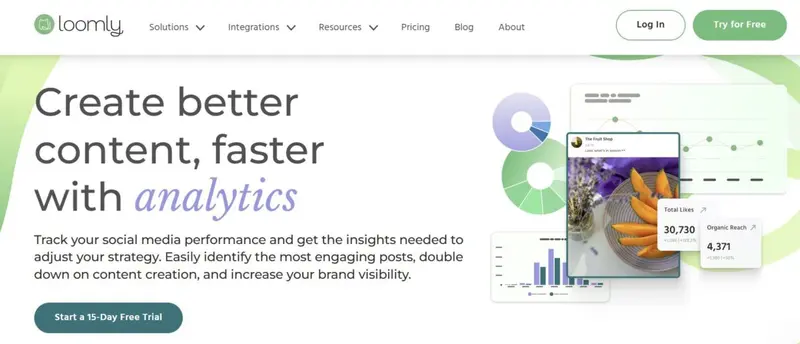
Best For: Beginners who need a straightforward influencer analysis tool.
Loomly is a basic real-time social media analysis tool that also provides insights into your influencer campaigns. You can use labels to categorize your social media posts by campaign types, such as influencer-led product launches or seasonal promotions.
From there, the tool lets you create links with UTM parameters to track influencer posts’ performance. You can segment data by labels and links so you know exactly which influencers are driving conversions.
Loomly shows you account-level growth to understand influencers’ overall impact on your social media presence. You also get a breakdown of each post’s engagement metrics, such as likes, comments, and shares.
These metrics can be filtered by date range, channels, and labels to pinpoint the performance of certain posts, creators, or campaigns. Once you set automated reports, you get them in your inbox at regular intervals.
Why It Stands Out: Loomly’s collaboration features make it an excellent option for small teams that need to track influencer campaigns without overwhelming features. Team members can leave private comments for each other. Plus, the review version logs let everyone see the adjustments and edits made to the influencer content before publishing.
5. Modash
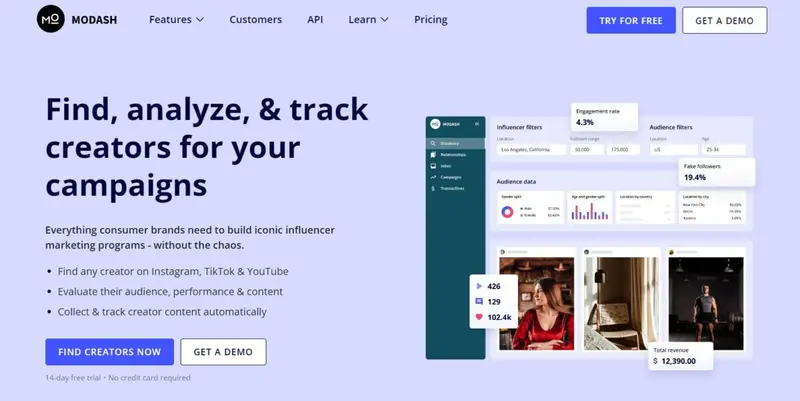
Best For: Teams that want specialized influencer discovery and campaign tracking in the same platform.
Modash is a highly reliable influencer discovery and tracking software that allows you to monitor all live influencer content, including Stories. The best part is that influencers don’t have to sign up for the platform, so they don’t have access to your campaigns or content outside of the agreed collaboration.
If you frequently create influencer-led promo campaigns, Modash will be the best influencer marketing software for you. Besides UTM links, you can also create promo codes and QR codes to track each influencer’s individual performance and contribution to your influencer marketing ROI.
As for post-level monitoring, you can view metrics like engagements, sales, clicks, comments, and more. The tool also provides a campaign-level and influencer-level view of the performance so you can easily identify the top-performing posts or creators.
Modash automatically collects influencer data from major social media platforms, so you don’t have to waste time manually entering information. You can also filter the information by content type, influencer, and data.
Why It Stands Out: The scalability of Modash makes it suitable for businesses of all sizes. Whether you’re collaborating with 5 creators or 5,000, Modash can cater to your needs. The platform also takes FTC guidelines seriously. If an influencer post is missing an ad disclosure or a critical hashtag, you’ll get an alert so you can make the necessary changes.

Key Features: Campaign Management, Influencer Discovery, Influencer Analytics, Influencer Campaign Monitoring, Influencer Management,
6. Upfluence
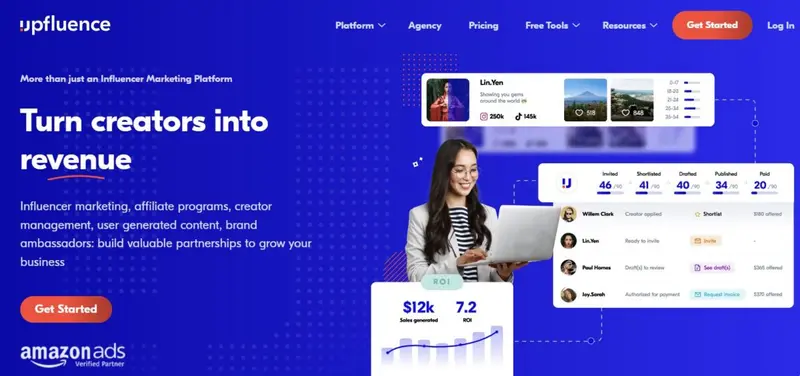
Best For: Brands that want to integrate their eCommerce data with influencer marketing.
Upfluence is a specialized platform dedicated to influencer marketing across not just social media but also eCommerce marketplaces. It provides you with a single content dashboard where you can see Shorts, Reels, videos, Stories, and other posts from different platforms, along with their engagement metrics and reach.
For each campaign, Upfluence also shows you the earned media value, which is the total value of all the influencer posts combined. You can further combine your sales data with influencer engagement metrics to get an accurate ROI measurement.
Besides direct sales, eCommerce influencer marketing software also helps you monitor ROI through coupon codes and affiliate link tracking. The Upfluence API also helps you integrate influencer data with your existing eCommerce platforms.
Why It Stands Out: eCommerce integrations with WooCommerce, Amazon, Magento, and Shopify make Upfluence one of the best influencer marketing platforms for eCommerce businesses. You can also integrate it with Hootsuite and Klaviyo to get a holistic view of your marketing efforts across verticals like email and social media.

Key Features: Influencer Search & Discovery, Relationship Management, Campaign Management, Third Party Analytics, Automated Recruiting, Influencer Lifecycle Management, Team Collaboration Tools, Content Review, Campaign Reporting, Audience Analysis, E-commerce Tools, Product/Gifting Tools, Payment Processing, Social Listening, Affiliate Management, Affiliate Campaigns,
Channels: Instagram, Youtube, Facebook, Twitch, Tiktok, Twitter, Pinterest, Blogs
7. IQfluence
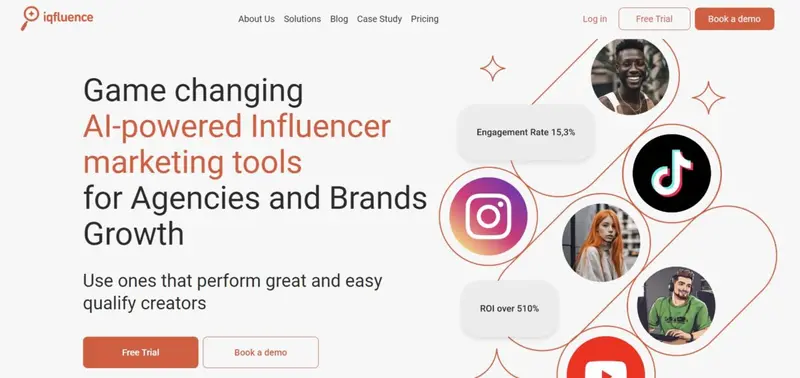
Best For: Marketers who need a budget-friendly tool without any extra bells and whistles.
IQFluence is an AI-powered influencer marketing platform that keeps influencer tracking simple yet comprehensive. The platform’s AI-assisted system makes it easy to find the right creators for your campaign. It does so by providing deep insights into influencer performance and precise filters to narrow down your options.
Possibly, the most notable feature of IQFluence is its creator blacklists. The tool’s AI technology eliminates creators with poor performance so that you spend your budget wisely.
Its proprietary TopicSensor further helps you scale influencer campaigns by providing data-driven insights. Besides your influencer selection criteria, the system also monitors creator performance by specific topics in your niche. Then, you get precise AI-driven recommendations for the best-performing influencers you should work with.
Why It Stands Out: Influencer marketing tools with too many features can often be overwhelming to set up for smaller teams and beginners. However, IQFluence is an ideal influencer marketing platform for small businesses due to its low complexity of use and AI assistance.

Key Features: Influencer Search & Discovery, Campaign Reporting, Analytics/Reporting,
Channels: Instagram, TikTok, YouTube
Reliable Data, Real Results: Getting Accurate Influencer Metrics
Influencer marketing only works if you can measure success, and that starts with getting accurate data. To do that, you need to start by determining the goals of your influencer campaigns.
What does success look like for you? Maybe you want to boost social media engagement through influencer content. If you've launched a new product through influencer collaborations, you'd want to measure website traffic and sales.
Every goal requires different tracking metrics. For example, engagement metrics (likes, shares, comments, comments) are measured when your aim is brand awareness. However, for content-driven promotions and ROI-focused campaigns, you have to measure clicks, sales, website traffic, and conversions.
However, measuring platform analytics isn't enough. Use unique URLs, UTM parameters, discount codes, or affiliate links to pinpoint exactly which influencer drove each result. Most influencer marketing tools let you generate these codes and measure them from the same dashboard.
For example, MercerLabs onboarded 200 creators through Upfluence and then used the platform to create affiliate discount codes in bulk for them. The company then monitored each code's performance to determine which creators drove the most conversions. They were able to generate 6x ROI by partnering with the top-performing influencers and tracking their results closely.
Speaking of monitoring results closely, it's best to cross-check data across multiple sources. No single tracking tool is 100% foolproof. Influencer engagement can be inflated, and platform data sometimes lags.
Compare platform analytics with Google Analytics to see if click-through rates (CTR) and conversion rates match up. Similarly, check influencer-reported data against your CRM to determine if sales and conversions align. You may also use two different influencer tracking platforms to compare results.
This level of scrutiny may seem excessive, but it's necessary to get an accurate understanding of your influencer marketing ROI. After all, you want to make data-driven decisions when selecting future collaborations and allocating budget.
Building Trust & Compliance: Transparency in Influencer Tracking
A big part of influencer marketing is doing it right. You don't only have to build transparency with your audience but also with the creators you work with. Plus, you must comply with the FTC's or your local regulatory body's guidelines.
First, create a contract that outlines all expectations and requirements for the collaboration. It should include details on the content type, posting dates, promotional messaging guidelines, and compensation. Also add a clause that states the requirement for FTC or local regulatory body compliance.
Many influencer tracking tools have built-in compliance features like:
- Auto-prompts: These are prompts that remind creators to disclose the nature of their partnership with a brand in their posts. A simple #ad or #sponsored tag in the caption is all that's needed.
- Pre-set Approval Workflows: Some tools let brands review and approve content before creators can post it. In these cases, the social media team will have to manually check for compliance.
- Compliance Alerts: Tools like IQFluence have compliance alerts to keep you informed about potential FTC or local regulatory body violations. For example, you get a notification if an influencer publishes your content without the hashtag specifying that this is a paid post. These alerts help you rectify issues before they escalate.
As for transparency, maintain open communication with creators. Regular check-ins can help you align expectations and address any concerns. You can also track performance metrics together to make sure the collaboration is meeting its goals.
Some influencers may also use their own analytics services. Work with them to compare the reports from your tracking tools and theirs to get a complete view of the collaboration's success.
Doing this will also help you monitor authentic engagement. Unfortunately, not all engagement is real, as fake followers and bot comments can inflate influencer performance, making the campaign seem more successful than it actually is.
You can avoid falling for this by using platforms with fraud detection features. Modash is one example of such a tool, but most other solutions also have some sort of engagement analysis. Also, go through the engagement manually. For example, read comments to see if they're actually relevant to the post.
Together, these tactics keep you compliant with regulations and help maintain transparency. You also build long-term relationships with influencers, which further benefits the brand as your audience associates the creators with your product or service.
Monitor, Optimize, and Adapt to Stay Ahead in 2025
Selecting the right influencers is just the beginning of your campaigns. Next comes the actual process of running the campaign and measuring the performance of each creator. Influencer tracking platforms assist throughout this process by providing real-time reports and (in some cases) AI-based recommendations for optimization.
At the same time, these tools help keep you compliant with regulatory guidelines, weed out influencers with fake engagement or followers, and build mutually beneficial relationships with creators.
Going forward, brands that use data-driven influencer marketing strategies will have a competitive edge. So, you can pick a tool that fits your needs and take that early step.
Frequently Asked Questions
Which influencer tracking tool works best for small businesses?
For small businesses, the “best” tool isn’t about enterprise-grade depth — it’s about striking the right balance between affordability, speed of setup, and integrations you’ll actually use. Loomly works well if you want a lean, intuitive platform that combines content scheduling with basic influencer monitoring — no steep learning curve, no wasted spend. Brandwatch, on the other hand, gives medium teams access to robust social listening and influencer discovery at a price tier below the full enterprise suite.
The real differentiator for SMBs is how well these tools plug into existing workflows (Shopify, Klaviyo, or Google Analytics) without forcing you to pay for advanced compliance or multi-market modules you don’t need. Start light with Loomly for campaign execution, layer Brandwatch if audience insights and sentiment analysis are a priority, and scale into heavier influencer attribution platforms only once ROI justifies the lift.
How do I attribute sales to specific influencers?
Relying solely on coupon codes or UTMs underestimates influencer contribution because much of the lift is view-through or latent demand. Experienced teams layer three models:
-
Direct attribution (UTMs, affiliate links, discount codes).
-
Incremental lift tests (geo-split campaigns, time-based control groups).
-
Assisted conversions (via multi-touch attribution in GA4 or Segment).
The strategic edge comes from running holdout tests—exclude a cohort from influencer exposure and measure lift in conversion velocity vs. exposed groups. That’s how you demonstrate impact to finance teams.
Is it possible to track ROI without coupon codes or UTM links?
Yes, but it requires proxy signals: branded search lift, affiliate revenue deltas, and audience overlap analysis. Use tools like Measured or Rockerbox to stitch anonymized path-to-purchase data across channels. Another overlooked option is post-purchase surveys (“How did you hear about us?”) weighted against media mix models. When scaled across multiple campaigns, survey data gives you directional ROI insights that codes alone can’t capture.
What metrics should I track to prove influencer campaign success?
Move past vanity metrics. The metrics that carry weight in boardrooms are:
-
Cost per incremental customer acquired (not just cost per engagement).
-
Customer lifetime value uplift (e.g., influencers who drive higher AOV or repeat rates vs. baseline).
-
Content longevity (does influencer content continue generating search/social impressions after campaign spend stops?).
-
Audience match rate (how closely influencer audiences overlap with your high-value CRM segments).
These metrics shift the conversation from “reach” to business impact.
Can influencer tracking tools ensure FTC compliance?
No tool can guarantee compliance — but the best platforms reduce exposure by flagging missing disclosures across posts and archiving proof of FTC-friendly tagging. Platforms like Tagger and Captiv8 run automated sweeps for #ad/#sponsored usage. The sophisticated play is to integrate compliance checks into your influencer briefs and then let the tool automate audit trails, so if regulators ever ask, you have timestamped evidence.
How do influencer tracking tools integrate with my existing CRM or analytics software?
The integration gap is where many campaigns underperform. Modern influencer tools use APIs or webhooks to sync directly into Salesforce, HubSpot, Segment, or GA4. What you want isn’t just “data import,” it’s audience-level stitching—so you can see which influencer-driven leads actually move through your funnel and what their retention looks like. A best practice is to set up common IDs (email, hashed phone numbers) so CRM records can tie back to influencer-driven events.
Can influencer tracking tools handle multiple campaigns at once?
Yes, but the question is how well they separate attribution across overlapping campaigns. Advanced platforms allow you to create campaign hierarchies (e.g., seasonal drops nested under always-on programs) and apply multi-touch weighting models. Without this, you’ll double-count conversions if one customer interacts with multiple influencers across campaigns. Look for tools with multi-campaign attribution logic, not just dashboard filters.
Is there a risk of data privacy issues with influencer tracking tools?
Absolutely. Any tool handling influencer audience data sits in a gray zone of PII, GDPR, and CCPA compliance. The main risk is over-collection (pulling follower-level demographics without consent). To mitigate:
-
Work only with vendors that operate on Instagram/YouTube/TikTok’s official APIs.
-
Demand a data processing agreement (DPA) from providers.
-
Avoid tools scraping data outside API guidelines (risk of shutdown + legal exposure).
The smart move is to audit vendors like you’d audit any MarTech partner: look for SOC 2 compliance and GDPR readiness.
What’s the easiest way to compare influencer performance across platforms?
Don’t just normalize CPMs or CPEs. The advanced way is to define a common denominator metric tied to outcomes—e.g., Cost per Incremental Purchase. Then build cross-platform dashboards that weight metrics according to funnel stage (e.g., TikTok for awareness, Instagram for conversion). Tools like CreatorIQ or Traackr allow for custom weighting formulas so you’re not comparing apples to oranges.
How do I incorporate affiliate links or discount codes into influencer tracking tools?
Affiliate integrations work best when codes and links are tied directly into your attribution system (Impact, Refersion, Rakuten). The key is granularity—assign unique codes per influencer and sync them into your influencer platform so they’re automatically reconciled with CRM data. Advanced teams also use tiered codes (e.g., seasonal or product-line specific) to understand what influencers are best at selling, not just if they can sell.













